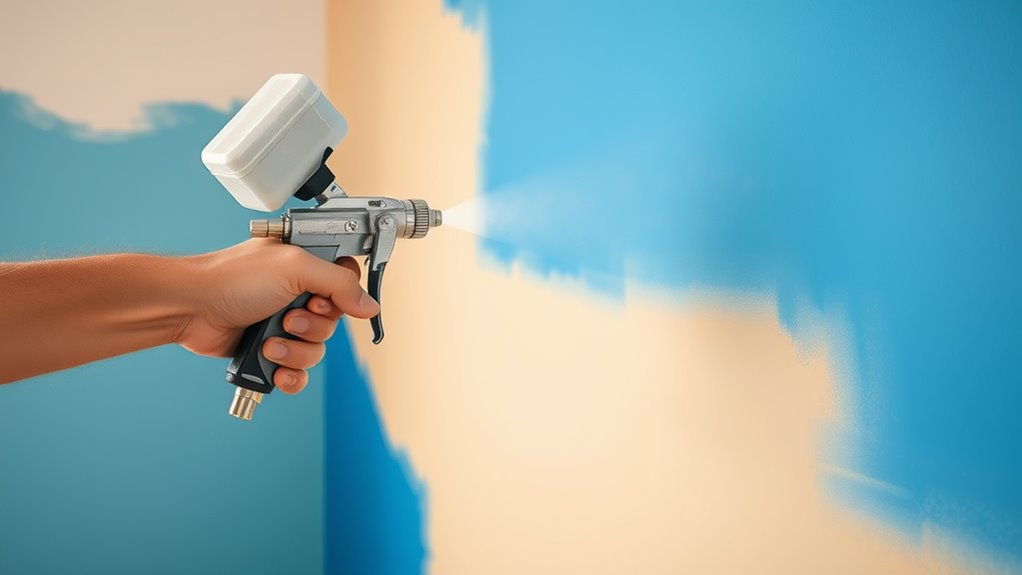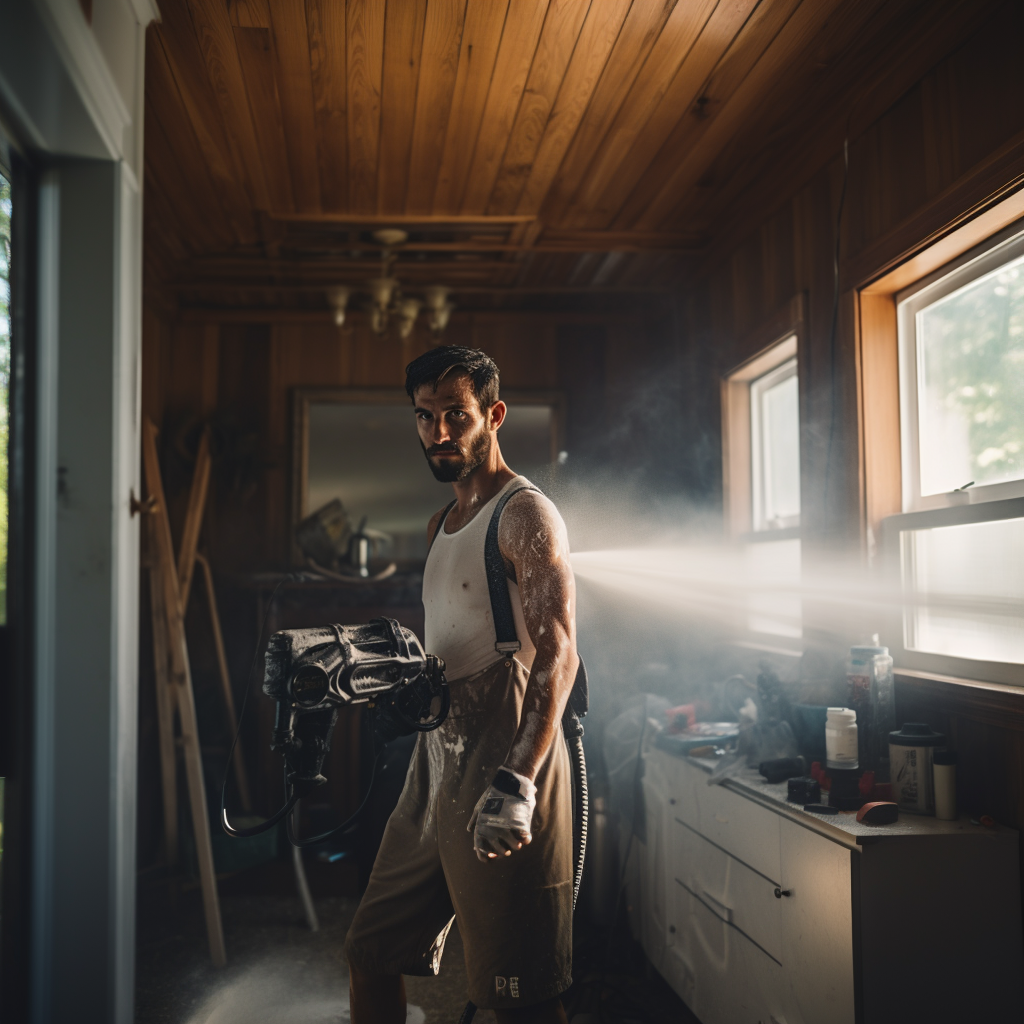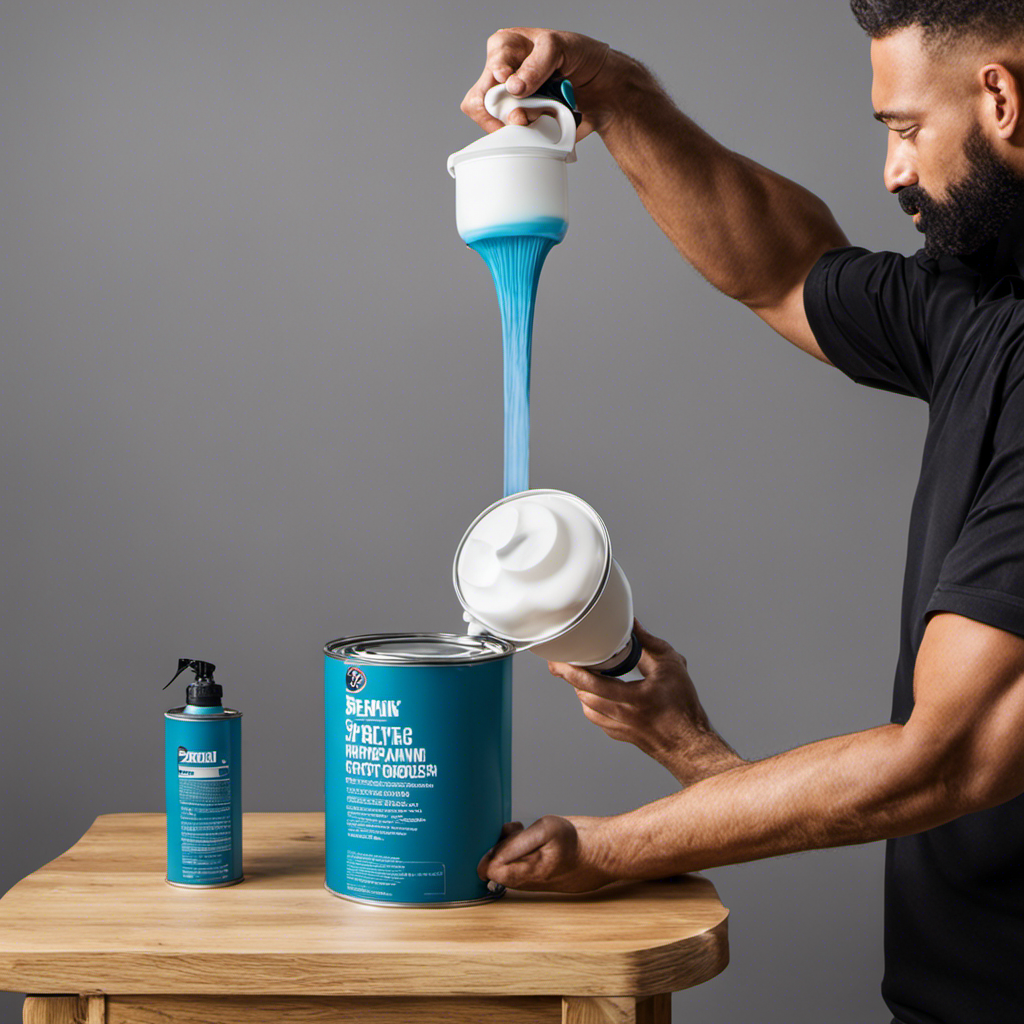To spray two-color rooms without bleed-through, start with a clean, dry surface and apply primer if needed. Use high-quality painter’s tape, pressing it firmly to prevent gaps, and seal edges with the base color before applying the second color. Apply thin, even coats, letting each layer dry completely before removing tape. For sharp lines, re-tape as necessary. If you want to master flawless two-tone finishes, discover more tips below.
Key Takeaways
- Use high-quality painter’s tape and press firmly to eliminate air bubbles and gaps.
- Seal tape edges with the base color or a primer to prevent paint seepage.
- Apply thin, even coats of spray paint, allowing each layer to dry completely before proceeding.
- Re-tape and reapply a light coat of the base color over tape edges for added protection.
- Perform touch-ups with a small brush after spraying to correct any bleed-through.

Ever wondered how to achieve crisp, clean two-color walls without any bleed-through? It’s a common challenge, but with the right techniques, you can create sharp lines and flawless color separation. The key lies in effective color masking and proper paint layering. These methods help prevent colors from bleeding into each other, ensuring your finished look is professional and polished.
First, start with a clean, dry surface. Apply a primer if necessary, especially if you’re working with dark or contrasting colors. Once the surface is prepared, decide which color will be your base coat. Usually, it’s best to paint the lighter color first, as it’s easier to mask over and less likely to be affected by subsequent layers.
Begin with a clean, dry surface and consider priming, especially for dark or contrasting colors.
When it comes to color masking, precision is *essential*. Use painter’s tape or specialized masking tape designed for sharp lines. Carefully press the tape down along the line where you want the two colors to meet, ensuring there are no air bubbles or gaps. For added accuracy, you can use a small brush or a masking pen to outline the tape edge with your base color, sealing any tiny gaps that might let the next layer bleed through.
Paint layering is equally important. Once your base coat has dried completely, typically 24 hours, you can begin applying the second color. Before you do, apply a light coat of the base color over the masked edge. This acts as a barrier, creating a seal that prevents the top color from seeping underneath. After this layer dries, carefully remove the masking tape. If you want crisper edges, you can reapply the tape immediately after the first top coat has dried slightly, then add a second top coat for extra sharpness.
To further prevent bleed-through, consider using a thin, high-quality brush or foam roller for the paint layers near the masking tape. Apply the paint in thin, even coats, allowing each layer to dry fully before adding the next. Thick coats tend to seep under the tape and cause smudges. If you notice any bleeding after removing the tape, lightly touch up with a small brush rather than re-taping, which can disturb the clean line.
Frequently Asked Questions
What Types of Paint Are Best for Two-Color Spray Projects?
You should choose high-quality latex or acrylic paints for your two-color spray projects because they offer good paint compatibility and smooth finishes. Use a primer suited for your wall type to guarantee better adhesion and prevent bleed-through. Opt for paints with low VOCs to reduce odor and fumes. Testing your paint layers beforehand helps avoid color bleed and ensures crisp separation between the two colors.
How Long Should I Wait Between Applying Different Colors?
You should wait at least 1 to 2 hours between applying different colors, depending on your paint’s drying time. Proper color selection and a careful spray technique help avoid bleed-through. Make sure each layer is dry before starting the next to prevent smudging or mixing. If you’re unsure, wait longer or lightly sand the edges for cleaner separation. Patience guarantees your two-color spray project looks sharp and professional.
Can I Use a Single Spray Gun for Multiple Colors?
Yes, you can use a single spray gun for multiple colors, but it’s not ideal for color mixing and avoiding bleed-through. To keep colors pure, thoroughly clean your spray gun between uses, which is vital for spray gun maintenance. Using separate nozzles or color-specific tips can help prevent cross-contamination, ensuring sharp, clean lines. Proper maintenance and cleaning make switching colors easier and help achieve professional results without unwanted bleed-through.
What Are Common Mistakes That Cause Bleed-Through?
You often cause bleed-through by skipping proper primer adhesion and ignoring paint compatibility. If the primer doesn’t stick well or isn’t suitable for your topcoat, colors can seep through. Also, using incompatible paints can lead to bleeding. To prevent this, make certain you use a high-quality primer suited for your surfaces, check paint compatibility, and let each layer dry thoroughly before applying the next. This minimizes bleed-through and achieves sharp, clean lines.
How Do I Fix Mistakes if Bleed-Through Occurs?
If bleed-through occurs, start by applying a primer sealing the previous color to prevent it from showing through. Use edge masking to create sharp lines and prevent paint from spreading onto the new color. Carefully sand any uneven areas before repainting. Re-apply the top coat smoothly, ensuring even coverage. These steps will help fix the mistake and achieve crisp, clean two-tone walls without bleed-through.
Conclusion
Now that you know how to prevent bleed-through when spraying two-color rooms, you’re ready to create crisp, clean lines that impress. Think of each coat as a brushstroke in your masterpiece—precision is your palette. With patience and careful masking, you’ll turn your space into a work of art, free from unwanted color clashes. So go ahead, spray with confidence, and let your walls tell a story of skill and style—without a single bleed to spoil the scene.
Franz came aboard the Paint Sprayer Zone team with a background in both journalism and home renovation. His articulate writing style, combined with a passion for DIY projects, makes him an invaluable asset. Franz has a knack for breaking down technical jargon into easy-to-understand content, ensuring that even the most novice of readers can grasp the complexities of paint sprayers.










